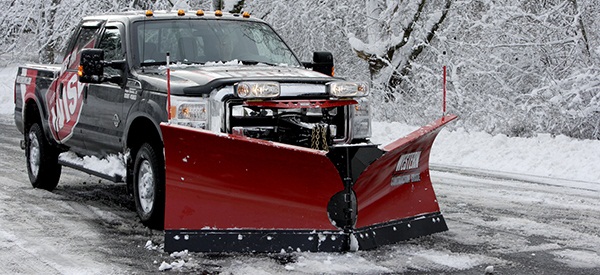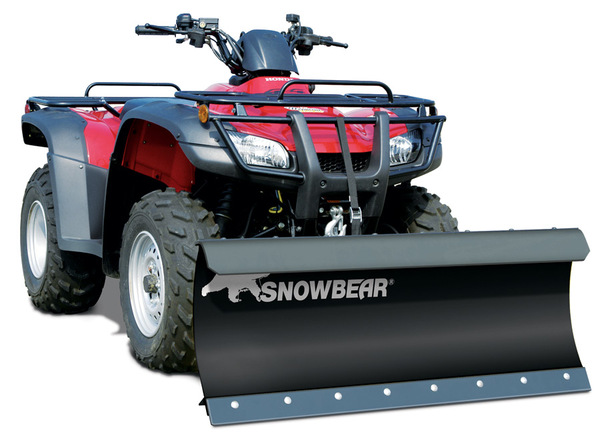Research: Snow on a long driveway
2014-03-12
Jess and I found a really cool piece of property in Vermont that's up a road that doesn't get plowed in winter. And I started researching various ways to deal with it. It's amusing enough that I thought I'd share some of my results.
Answer #1: Large truck and plow
Okay, sounds pretty reasonable. There's a ton of forums where folks who do plow professionally chat about how to do it. I dug through these a while, as well as some manufacturer websites. What I came up with was not encouraging.
If you get more than about 3 inches you need to "plow with the storm". If you don't apparently it can be very difficult for your truck to get through it. Sure you can probably get that up to 6 or so inches with a good large truck and a good plow, but what if I'm off visiting my folks for christmas when this happens? With a short driveway you go "well shit" and you shovel it, and it sucks but you can get to your house. With a 1/2 mile of road... not so much.
Apparently if you try and plow deep snow it puts a lot of strain on your truck. You need a true heavy-duty truck with extra modifications, plus a special ram plow, and some folks say to never put chains on as the extra traction is likely to cause you to break an axle... wow, okay.
Answer #2: Snowblower
You're kidding right? 1/2 mile with a stupid little push snowblower?
Answer #3: ATV with snowplow
This seems to work surprisingly well. Because it's so much smaller than a truck it seems ATVs handle the stresses much much better, and surprisingly can actually push *more* snow. Now, after many years of snowplowing with a lawnmower I'm quite familiar with the limitiations of this sort of approach, and it's mostly *weight*. If we used this solution we'd likely end up putting tracks on the ATV for logging and such anyway, so it would could push a lot more than our old lawnmower, but it's still pretty limited.
Answer #4: ATV with a snowblower
This looks pretty viable. Up to say 18" of snow this seems to work very well. An interesting catch is that ATVs don't have a PTO, so the snowblower runs off of it's own engine. This is kindof awkward, and means we have another engine to maintain who's reliability is paramount... ugh. But, with the right width you could do this in one run down the road, turn around and come back up the other side, and it'd be done. Not bad.
Answer #5: Unimog with a snowblower

Okay, this is a little silly, but it'd work. A unimog is a special type of tractor designed to double as a truck. It's got portal axles and is known as one of the best offroad vehicles in the world. It would double as a vehicle for getting to town and towing a large trailer. Being a tractor though it's got a PTO, and there are some sweet snowblowers made for it. Also, if the snowblower fails there's a good chance you could just drive out anyway. Downside is that these things are hard to keep running, and you can only get old ones in the U.S.
Answer #6: Something else with a PTO and a snowblower
Well, that would probably be a tractor. Many don't have PTO's on the front. 1/2 mile is just too damned far to back a tractor. To have it on the front would require another engine, with similar downside as the ATV. Also, even if it has the PTO on the front, a fullsized tractor is pricey if that's all we intend to use it for. But, this is likely a good option if we decide we need a tractor anyway.Answer #6: Why are we trying to move the snow again?
Get a snowmobile and to hell with it. Find a place to park the car down on a plowed road, and just snow-mobile to it. This is a very attractive option as you just don't have to care about the snow getting deep. Plus I mean... snowmobiling, what's not to like? Obviously cross-country ski's would be the backup option if the snowmobile breaks down. Unlike other options if your mechanical solution fails the car isn't behind 1/2 a mile of snowed in road.We were toying with getting an ATV anyway, for doing selective logging on our own land. It's best to do it in winter as it causes less damage, so this is another option (though not legal on local snowmobile trails).
Answer #7: If that's a good idea, what about a snowcat?
Lots of reading about cool old snowcats later, they are kindof a pita to maintain. They have almost no advantages for my sort of purpose over a snowmobile, and quite a few disadvantages. But... I learned a lot about snowcats, so that was a lot of fun :).Conclusion
To be clear, I grew up shoveling snow. My parent's have a snowblower attached to a lawnmower now that works pretty well. I'm not unfamiliar with snow-clearing and problems like super heavy snow, or the snow that already got pushed around by the town plows. What was interesting here was considering the feasibility of different solutions to 1/2 mile or so of snow between your house and a plowed road.I'm thinking in reality some combination would probably be best, like an ATV with tracks and a little blade, and park one of two cars where it can get out if we can't clear the road. Then just pop the blade off and drive down on the ATV to the other car. Also, having our normal vehicles have 4wd and such we can probably often drive directly over the snow anyway.
Most likely we won't end up getting a place requiring all of this, but the research was both fascinating and hilarious, so I thought I'd share.
Review: Taylor 1522 Indoor
2014-03-11
As a house thermometer it's probably fine, but don't let it get cold.

We purchased this thermometer for our truck. We go out in all sorts of different weather, and especially after our stint in
Montana last November
I thought it would be nice to know what temperature it was both inside and out of the truck body.
The thermometer fit perfectly in our 2002 Tacoma. We pulled the ashtray and pushed it up into the remaining hole using double-sided tape to hold it in place at the top and at the back against the face below it. It worked great!
I then ran the outdoor sensor through the hole in the carpet and floor. The hole in the floor is as from the factory, it just had a rubber plug I had already pulled out for running a radio antenna wire. I had also slit the carpet for the same purpose.
My first attempt had the sensor inside the frame, this didn't work as too much heat got stuck there and the thermometer was WAY off if the engine was running. So next I moved it to the outside of the frame and back a ways, tying it to the rear cab mount on the frame. That worked great. We compared it to thermometers on banks, and at houses we were staying at, and it seemed to read about right.
Now comes the problem. Jess and I were up looking at land up in Vermont, and slept out in the truck. Temperatures got pretty cold that night, but not THAT cold, maybe down to 0 or so, and in the morning the thermometer didn't work, and hasn't worked since.
So, it's probably a fine thermometer for house use, but do not buy this for a vehicle, or for use anywhere that drops notably below freezing.
To Vermont!
2014-03-10
Probably.
Back when Jess and I hiked the AT we talked about it and decided to stay in normal fulltime tech work a while longer to build up some money. We succeeded in getting a nice little nest-egg for ourselves, and as you all know quit our jobs and went on adventures this summer. The goal though was always eventually to use that money to get some land. The hope was that this would open whole new worlds of opportunities to live with the land, and help it help us prosper.
Several months back Jess and I were talking and trying to decide what we wanted to do next. We rolled around various crazy things to do related to stuff we talk about on this site - like guiding, teaching outdoor skills, homesteading, tanning, hunting, logging, farming, land-management etc.
As we talked it slowly sank in that neither of us wanted to do any of those things full time. We were also both loath to give up software engineering entirely. This may sound odd to some who read this blog, but I love programming, and I crave that type of problem solving. It's such a pure form of thought, requiring and thus inspiring a type of clarity of thought in general. That clarity becomes a habit at invades how you do everything, I LOVE it. That way of thinking is why I got into computer science in the first place, and I have no desire to give it up. I really want to do woodworking and all the rest, but I still want to program, I just want to do it *less* than I used to.
My old "server"
Then we realized that part-type remote tech work exists. In fact, there's a fair amount of it out there, especially for my skillset. With that in mind, Jess and I have been trying to decide where to house-hunt since before the holidays (with that little medical side-trip in the middle). Jess will get probably a fulltime remote job because she wants to keep doing techy management stuff, and I'll likely find some part-time tech work. Then we can spend the rest of our time on the type of stuff you see in this blog.
So, how does one decide where to live? Not knowing where to start, and being nerdy engineers, we started like any one of those proclivities would. With a list of goals:
- Good enough internet for videoconferencing
- Forested land to manage
- Deciduous trees (we both have a fondness)
- The right mix of folks, politics, and education levels
- Large public lands to play on
- Has Weather
With this in mind we quickly paired it down to a short list. We visited a few places on the short-list, did some research on local politics, temperatures, etc. and after not too long had it down to Washington, Vermont, or Virginia. Vermont and Virginia beat Washington in the end for being near our families. After a few road-trips looking at examples houses and towns we chose a small area in Virginia and another in Vermont that we decided we liked. Decisions are hard, but all things together Vermont looked better in most dimensions, so right now we're pursuing the Vermont idea. The snow's made it interesting as well.
Our next step is probably to rent a place in that area of Vermont while we find a place and strike a deal. I've been spending almost all of my free time for the last couple of weeks reading about buying land, researching different types of house construction, researching various methods of transportation on the snow, different ways to clear driveways, off-grid systems, passive solar systems, insulation, housing codes, outhouses and composting toilets, etc. It's a lot to learn, but it's fun and exciting! We've been using a (slightly older version of) this book:

In the meantime it's been pretty cool hanging out with both our parent's again. It's always great to have a place to go back to in-between things, and people who love you and who's counsel you can consult.
So, with some luck you should be seeing a bit more of us around White Mountain National Forest in New Hampshire, and out on the Long Trail.
National Scenic Trails
2014-02-22
Many people have heard about the Appalachian Trail, the Pacific Crest Trail and maybe even the Continental Divide Trail, but that's just scratching the surface in terms of what long trails are out there.
The official National Scenic Trails map can be
downloaded here
(it's a pdf).
There are plenty of other medium length trails out there that don't show up on this map such as the
Long Trail
, the
Baker Trail
and the
Tuscarora Trail
. That's because this map only shows trails officially designated as National Scenic Trails, but it's a good start for dreaming.
Review: Underarmor Winter Weight Running Tights
2014-02-15
I've had a pair of these since college, and it still hasn't worn out.
My use case
These are my warm base-layer for the lower half of my body... for all activities. My main goal is to keep the wind layer off my skin, keep my knees safe from freezing, keep the blood warm on the way to my feet.I originally bought them to run to campus, I'd wear them under a pair of thin unlined windpants (specifically these http://www.blog.smalladventures.net/2010/12/gear-review-montane-windpants.html ) to run to school during the winter. It got down to -10F occasionally, and I'd run through a park up over a hill with relatively decent wind gusts, so I needed it.
Since then I've used them all over the place.
- hailstorms in Yosemite: http://www.blog.smalladventures.net/2010/11/yosemite-and-hail-tail-of-fun-despite.html
- -25F in Montana (with puffies as well): http://www.blog.smalladventures.net/2013/12/theres-cold-and-theres-cold.html
- 9F degrees and soaking wet digging a snowcave at midnight: http://www.blog.smalladventures.net/2010/03/trip-report-first-time-snowcaving.html
- Under a drysuit in a river when it's below freezing: http://www.blog.smalladventures.net/2013/10/advanced-swiftwater-rescue.html
When I'm not active I add a puffy layer between the tights at the pants. This will get me down to about 0F in relative comfort (given good boots).
What they are good for
Here's the key. They are really not very warm alone. If you want them for serious warmth you really need to block the wind somehow. Even if they are soaking wet they are still pretty warm (as demonstrated by that snowcave trip) if something is blocking the wind. I think of them kindof like a wool sweater, but with way less wind-blocking ability.No doubt had I gotten wool way back then I'd be extolling the virtues of wool tights. I really prefer my clothing to be biodegradable, which these aren't. That said, Jess has been through a couple of pairs of tights in that time. There's no question that these last longer than most of the wool tights available.
Will I buy them again
Probably not.Although these have been amazing, when they wear out I will almost certainly try something more biodegradable... I.E. something wool. I expected that that would occur several years ago actually, but they are still going strong. Of course, if the wool doesn't doesn't work I'll quickly be back.
Can you get them?
Maybe.Exactly what I got doesn't seem to be available anymore. Here's something that I'm pretty sure is sufficiently close though. Another similar pair is linked from our gear list :

Under Armour Men's UA EVO ColdGear® Compression Leggings
Conclusion
Great tights for a lot of situations, good as the base component of a layering system. They last a long time. They're not biodegradable. They are warm when wet. They're Mostly useful with pants over them (which is why I have so few useful photos).Why do people buy pants that are waterproof *and* insulated? Occasionally the convenience seems worth it, but it's so much less flexible. Seperating the layers I can throw puffy pants in between the two layers, or swap the outer layer between wind and rain pants, or even just some tough 5.11's, or wear them alone if that's just right. Doing that I end up with way fewer pieces of clothing, which means less stuff to push around and choose between when packing, and a lighter pack in the end.








